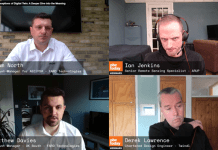As poor data practice cost the global construction industry an estimated $1.84tn in 2020, Sven Boesen explores how digital twins could reduce inefficiencies
Can construction technology -such as digital twins help to address these legacy infrastructures and drive savings in meaningful ways? Delays and cost overruns afflict many of the UK’s biggest infrastructure projects today.
Britain spends eight times more on road and rail projects than its European neighbours, and UK construction projects are on average running £7.6m over budget due to legacy inefficiencies.
From early design phases, to every day operational efficiencies, to massive scaling of operations, many top construction organisations are focusing their technology efforts on building digital twins to solve these inefficiencies directly.
How can digital twins reduce data inefficiency?
A digital twin is a virtual replica of a physical asset or system created by collecting data from smart sensors. Through being programmed to respond as the real-world would, digital twins enable better management of a range of performance scenarios. The technology supports better testing to strengthen the performance of construction projects, as well as business operations, by working with materials and systems more intelligently.
Tilbury Douglas, a leading U.K. building, infrastructure, engineering and fit-out company, has invested in digital twin technology to drive innovation and efficiencies in the earliest stages of construction projects.
They built an award winning real-time 3D configurator for smarter and more efficient creation of concept designs using approved standardised layouts.
By using prefabricated models and the latest 3D technology, Tilbury Douglas’s “Connect Configurator” empowers clients to make quicker and more informed decisions on their projects at concept stage, based on live cost, carbon and time estimates provided by the configurator as they design a building.
Creating a smoother design process
Digital twins can be critical in offering safe and relatively inexpensive testing grounds in an industry beset by inaccurate data and rework.
And it’s not just the UK construction industry that is experiencing these issues. It’s estimated the cost of bad data in the global construction industry amounted to approximately $1.84tn in 2020.
In the US, poor project data pertains to 48% of the rework occurring in construction. Digital twin technology can significantly address this issue with its ability to present real-time data and modelling on a project lifecycle, saving time and money.
Digital modelling provides a crucial bridge between design and construction, thus reducing the need for rework at a later stage. An example is New York based, award-winning architecture firm SHoP Architects and their use of Unity Industry, a suite of real-time 3D products and services for developers, artists, and engineers to build custom applications for augmented and virtual reality.
SHoP wanted to lower construction time and costs by making building information modelling (BIM), more visual, interactive, and available. Through using Unity, SHoP, streamlined the creation of real-time 3D experiences, taking minutes instead of days to optimise large design models.
Consequently, SHoP used Unity technology to develop a real-time BIM application for The Brooklyn Tower, the borough’s first supertall and the city’s newest landmarked building standing over 1,000 feet tall. The 73-story residential tower under construction is set to be the tallest structure in Brooklyn. The application makes it possible to view documents and information based on BIM data. Democratising access to BIM on any device streamlined communication with stakeholders to reduce change orders, construction time, and ultimately cost.
On average, change orders account for 8 – 14% of capital construction projects. On projects of the scale SHoP frequently works on, mitigating even one change order with this technology saves significant amounts of time and money.
The way ahead for digital twins
SHoP’s work with Unity is just one example of where digital twin technology can drive efficiencies. Obayashi, one of the largest construction companies in Japan, built a real-time 3D viewer application that allows anyone on their team to quickly build and view digital twins of its construction sites. Large companies like this around the world are leaning on digital twins to help reduce operating costs, create instructions more effectively, and better communicate with different stakeholders and clients.
The Architecture, Engineering and Construction (AEC) industry has historically been among the slowest to digitise and innovate. Encouragingly though, this is changing rapidly. An estimated $50bn was invested in AEC technology between 2020 to 2022, 85% higher than the previous three years, as more and more investors recognise technology’s potential to fundamentally change the structure of the construction industry.
The deployment of digital twins within the construction industry will be key to capturing this opportunity and driving efficiencies. The digital replication these technologies allow for can enable remote monitoring and data collection, decreasing waste and reducing accidents, all importantly leading to increased productivity.
There is no easy fix to the complexities of construction in any country. But digital twins can help address the delays and cost overruns that have historically hampered the UK construction industry where some infrastructure famously dates back to Victorian times.
By bringing together hardware, software, and data, the UK can succeed in modelling and upgrading legacy infrastructures and implementing new systems, more intuitively and affordably. Digital twins are a major change in construction, and the UK must be at the forefront of this evolution.
Sven Boesen
Global studio lead

















